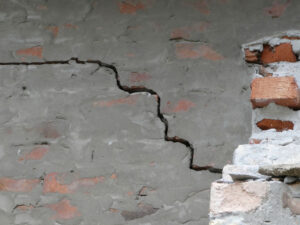Anyone who lives in Chicago knows how unpredictable the weather can be. One day it’s freezing, the next it’s melting, and then it’s freezing again. While most people think about how this affects their commute or their pipes, few realize just how much this constant freezing and thawing can damage a home’s foundation. At First Choice Inspectors, we’ve seen countless examples of small cracks turning into serious structural problems because of Chicago’s seasonal temperature swings.

The Science Behind the Freeze-Thaw Cycle
When water seeps into tiny openings in your foundation or the surrounding soil, it doesn’t just sit there. Once temperatures drop, that water freezes and expands. The expanding ice pushes against concrete, block, or brick, putting pressure on every weak spot. When the weather warms up, the ice melts, and the material contracts. Each time this happens; those materials flex a little more. Over time, this movement weakens the structure and opens larger cracks that allow even more water to enter.
Because Chicago’s winter weather can fluctuate so often, a foundation might go through dozens of these freeze-thaw cycles every season. Add in heavy snowmelt and moisture from rain, and it’s easy to see how this process can lead to long-term foundation issues.
What Freeze-Thaw Damage Looks Like
- Cracking in Walls and Floors
The first signs of trouble are often hairline cracks that grow larger over time. Vertical cracks often point to settling or shifting in the soil beneath the foundation, while horizontal cracks are more serious and may suggest that soil pressure is pushing inward. Both should be evaluated before they allow moisture inside.
- Uneven or Heaving Floors
When soil beneath a slab freezes, it can expand upward, creating pressure that lifts parts of the floor. Once the soil thaws, it might not settle back evenly, leading to uneven surfaces or tripping hazards.
- Moisture and Leaks in the Basement
Water always follows the path of least resistance. Once cracks open up, meltwater and groundwater can seep into basements or crawlspaces. Damp walls, musty smells, or white mineral deposits are signs that water has already found its way in.
- Doors and Windows That Stick
If your home’s foundation shifts, even slightly, the frame of the structure moves too. Suddenly, doors that once closed smoothly start sticking, or windows no longer slide easily. These small inconveniences can point to bigger structural movement.
- Chimney or Wall Separation
A leaning chimney or gaps between your home’s exterior walls and trim can signal differential movement caused by freeze-thaw cycles. What looks like a simple crack in mortar may be a sign that part of your foundation has shifted.
Why Chicago Homes Are at Risk
The soil in the Chicago region is rich in clay, which expands significantly when it freezes and contracts when it dries. This “heaving” movement creates uneven pressure beneath your home. Older homes built with stone or block foundations are particularly vulnerable since mortar deteriorates faster under the constant stress of expanding and contracting soil. Even newer concrete foundations can develop weaknesses if water isn’t properly managed around the home.
How a Foundation Inspection Can Help
A professional foundation inspection can reveal problems before they become serious. At First Choice Inspectors, we use advanced equipment, including thermographic imaging, to identify signs of moisture and temperature differences that indicate hidden problems behind walls or under floors. We carefully evaluate cracks and any visible movement, determining whether it’s cosmetic or structural.
Every client receives a detailed HomeGauge report that outlines what we find, why it matters, and what to do next. Whether it’s sealing minor cracks or addressing drainage issues, you’ll know exactly how to protect your investment.
Ways to Protect Your Foundation
You can’t stop winter from coming, but you can take steps to reduce the stress it places on your foundation:
- Make sure gutters and downspouts are clear so water drains away from your home.
- Check grading around your house to ensure the ground slopes outward.
- Seal small cracks before winter to keep water out.
- Use dehumidifiers in the basement to manage indoor moisture.
- Schedule professional inspections regularly, especially after heavy snow or flooding.
Don’t Let the Weather Win
Your foundation is the base of your entire home, and protecting it means protecting everything built on top of it. If you’ve noticed cracks, sloping floors, or water intrusion in your basement, it’s time to take a closer look.
At First Choice Inspectors, we specialize in identifying foundation issues caused by Chicago’s tough climate. Our team can help you catch problems early and keep your home safe, dry, and structurally sound for years to come.
Call 773-429-9711 or contact us today to schedule a foundation inspection and get peace of mind before the next freeze sets in.